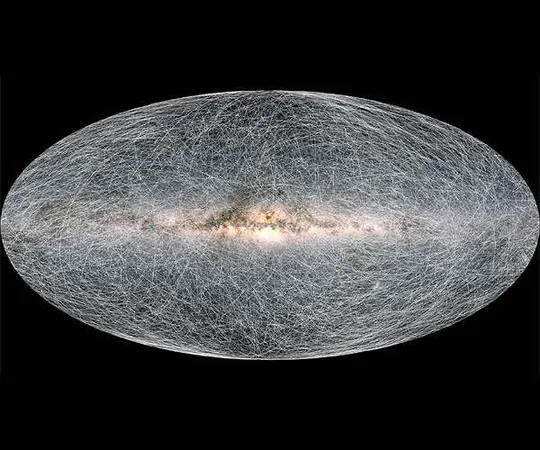
Gaia Space Telescope Enters Retirement: A Legacy That Will Shape the Future of Astronomy for Decades!
2025-03-28
Author: Ming
Retirement of the Gaia Space Telescope
In an event marking the end of an era, Europe’s Gaia space telescope has officially been powered down and sent into “retirement.” After a decade of groundbreaking work unveiling the mysteries of the Milky Way, its legacy promises to endure and continue influencing astronomical discoveries for the years to come.
A Decade of Discoveries
Launched in 2013, Gaia has meticulously charted nearly two billion stars, capturing their positions, movements, and properties, ultimately creating an unparalleled map of our galaxy, as highlighted by the European Space Agency (ESA). Nestled in a stable orbit approximately 1.5 million kilometers (about 930,000 miles) from Earth at the second Lagrange point, Gaia has operated in a unique vantage point that has furthered our understanding of the universe.
Strategic Retirement
Recent advancements in space exploration, especially with the powerful James Webb and Euclid telescopes now joining the celestial observation roster, demanded a strategic move for Gaia. To prevent any interference, ESA engineers initiated a final engine burn to propel Gaia into a “retirement orbit” around the Sun, ensuring it will remain at least 10 million kilometers away from Earth for the next century.
Unveiling the Milky Way's Secrets
During its nearly 11 years of operation, Gaia has unearthed astonishing discoveries, including evidence of colossal galaxies colliding, identification of vast star clusters, and the discovery of new exoplanets. One of its remarkable findings was the detection of two ancient star streams at the heart of the Milky Way, believed to have originated over 12 billion years ago, providing insight into the galaxy's formative years.
Mapping Galactic Growth
Furthermore, Gaia has played a crucial role in mapping the Milky Way's voracious growth, swallowing several dwarf galaxies, including Gaia-Enceladus, around 10 billion years ago. This tidbit of cosmic history underlines the dynamic and often violent evolution of our galaxy. Presently, Gaia continues to reveal ongoing galactic feasting, currently showcasing the slow consumption of the Sagittarius dwarf galaxy. The telescope’s capabilities also led to the identification of over 50 dwarf galaxies in orbit around the Milky Way and the tracking of 150,000 asteroids, along with several dozen black holes.
System Deactivation
As the mission wrapped up, ESA engineers in Darmstadt, Germany, meticulously deactivated all systems essential for survival in the harshness of space, including safeguards against radiation storms and micrometeorite impacts. ESA operations engineer Tiago Nogueira illuminated the highly sophisticated design of Gaia, where disconnecting systems isn't straightforward, marking a significant operational challenge.
Future of Gaia's Data
With systems now powered down and communication systems silenced, the scientific journey continues back on Earth. Astronomers are eagerly analyzing the vast wealth of data transmitted from Gaia, with the anticipated delivery of the fourth stellar catalogue expected in 2026. This catalogue, along with a final compilation expected around 2030, will comprise over a decade’s worth of meticulous observations.
A Lasting Legacy
Gaia's data will not just serve as a monumental reference in astronomy—it is anticipated to be a foundational resource for the next 30 to 40 years, continuing to provide a treasure trove of discovery potential. As José Hernandez, a Gaia engineer, aptly noted, some of the future astronomers poised to unlock new revelations using these data are “still in primary school.” This sentiment encapsulates the legacy of Gaia—a legacy that not only honors the past but also inspires the next generation of scientific exploration.
Conclusion
In the vast expanse of the cosmos, while Gaia may drift in silence, its monumental impact will resonate through the ages, fueling humanity’s eternal quest to understand the universe.




 Brasil (PT)
Brasil (PT)
 Canada (EN)
Canada (EN)
 Chile (ES)
Chile (ES)
 Česko (CS)
Česko (CS)
 대한민국 (KO)
대한민국 (KO)
 España (ES)
España (ES)
 France (FR)
France (FR)
 Hong Kong (EN)
Hong Kong (EN)
 Italia (IT)
Italia (IT)
 日本 (JA)
日本 (JA)
 Magyarország (HU)
Magyarország (HU)
 Norge (NO)
Norge (NO)
 Polska (PL)
Polska (PL)
 Schweiz (DE)
Schweiz (DE)
 Singapore (EN)
Singapore (EN)
 Sverige (SV)
Sverige (SV)
 Suomi (FI)
Suomi (FI)
 Türkiye (TR)
Türkiye (TR)
 الإمارات العربية المتحدة (AR)
الإمارات العربية المتحدة (AR)